 | E-mail to Birds Korea |
 | KWBS |
in the Region
 | The Oriental Bird Club |
 | BirdLife International (Asia) |
January
In occasional periods of extreme cold many smaller rivers and reservoirs freeze over. Temperatures often drop to -5°C at night, and stay near freezing in the day. Periods of light snow and severe cold are usually followed by milder temperatures, and then severe cold again.
A guided tour can expect about 160 species in 12 days if all the best areas are visited, and winter specialities include Baikal Teal (in often huge concentrations) and Scaly-sided Merganser, Swan and Lesser White-fronted Goose, Steller's Sea Eagle, Relict and Saunders's Gulls and Solitary Snipe! Red-crowned Cranes stand out on tidal-flats at Ganghwa, while White-naped and Hooded Cranes can be found in the south. Huge numbers of ducks and geese fill sites like Haenam and Seosan's Cheonsu Bay. Siberian Accentors can be common. On the southern island of Jeju milder conditions allow White's and Pale Thrushes, Olive-backed Pipits, and Red-flanked Bluetails to overwinter along with Korea's only regular winter Black-faced Spoonbills, and several thousand Mandarin Duck.
January highlights in 2002 included Korea's first Slender-billed Gull at Gwangyang, and in 2003 Chinese Nuthatch and Grey Buntings at several sites in the northwest, and southeast respectively. In 2004 a Long-tailed Shrike was on Jeju, while two Red-crested Pochard (seventh national record) were present at Joonam reservoir mid-month, whilst January 2005 was notable for a Ferruginous Duck and at least two over-wintering White-bellied Green Pigeons.
(The following records are a compilation of our own sightings and records sent in by other observers. As well as being posted on the Birds Korea website(s), selected records are also forwarded to other Korean-language birding websites; records of threatened species are arranged and forwarded to Birdlife International and national authorities when appropriate; flag images and records are passed to bodies responsible for their coordination throughout the flyway; and all records sent to us are used to compile annual reports and to support the evolving understanding of the status of many of Korea’s birds.)
Geum River and Estuary-Seosan, January 31
In subzero temperatures only 4 Swan Goose and 11 Baikal Teal found on the Geum, though prolonged views of an adult Lesser White-fronted Goose (apparently a different individual from the one of the week before) in with ca 2000 Greater White-fronteds. At Seosan, heavy snow and drifting winds limited birding, with the only surprise a Short-eared Owl flushed from the road side towards dusk.
NE River, January 30
Excellent views of 12 Scaly-sided Merganser (now 4 males and 8 females), with a supporting cast of 3 White-tailed Eagle and 3 Cinereous Vulture.

Nakdong, January 29
No success looking for Grey Bunting, but instead an excellent range of species on the Nakdong, with ca 8 Swan Goose, 20+ Saunders's Gull, 20+ Black-eared Kite, 2 Osprey, 1 probable Eastern Marsh Harrier, 2 or more White-tailed Eagle and best of all one adult and one indeteminate age Steller's Sea Eagle -- the latter with clean white tail, but otherwise blackish plumage apart from some whitish edges to the wing coverts on the closed wing.
Gunsan Airport, Geum River, Oh-seong Mountain and Eunpa Park, January 30
Starting out the morning near the Airport, we observed a female Hen Harrier. Also in that vicinity a small group of Olive-backed Pipits were seen.
A Peregrine Falcon harassed the ducks at the Geum Estuary, making several high speed runs at the Common Shelducks there. Only a few thousand Baikal Teal remained up river and with a cold biting wind we decided to look for passerines in sheltered areas around Oh-seong Mountain. The usual assembly of tits and woodpeckers were encountered over the mountain side. Best birds were a skulking Pale Thrush and a Japanese White-eye (PN).
East of Eunpa park in Kunsan a second Pale Thrush was encountered as well as a very close up male Eurasian Sparrowhawk perched just a few feet away.
Jeokseong, Imjim River, January 29
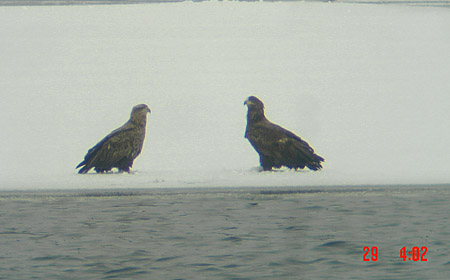
A dreadful Saturday with a blizzard in Seoul. At my favourite area along the Imjin River, geese were not in such large numbers and the vultures clearly had been grounded by the snow. Best birds though were 2 Scaly Sided Merganser with Common Mergansers.
The visit also produced several raptors including White-tailed Sea Eagle (2), Hen Harrier (1 female), Rough Legged Buzzard (1), Kestrel and Cinereous Vulture (12), and also Teal, Pintail, Goldeneye, Ruddy Shelduck (3), Long Billed Plover (1), Japanese Pygmy Woodpecker (1), Yellow Throated and Rustic Bunting (flocks up to 25 individuals) and Brambling.
Guryongpo Peninsula, January 28
In warm sunshine (with temperatures reaching a balmy 10C), good numbers of a wide range of species. Highlights included ca 18 Glaucous and 3 Glaucous-winged Gulls, 100+ Red-necked Grebe (an exceptional count in Korea), ca 150 stejnegeri White-winged Scoter and 20+ Harlequin Duck, several hundred Ancient Murrelet, 2 close-in Rhinceros Auklet, and excellent views of 2 Pacific Loon.

Haenam-Suncheon Bay, January 27
ca 300 Eastern Taiga Bean and between 3 and 5 Oriental White Stork were obvious highlights in Haenam, while ca 40 Hooded Crane at Suncheon were more expected than a single Chinese Grey Shrike there.
Geum River am, Haenam pm, January 26
A successful morning (once the fog had cleared!), with ca 250 osculans Oystercatcher and 23 Swan Goose in the estuary, and 6 200 Baikal Teal and a single adult Lesser White-fronted Goose on the "lake". Our search for at least 8 Oriental White Stork present in the Haenam area in the evening (per and thanks to Lee Jeong-Sik) sadly proved unsuccessful due largely to time constraints...
Seosan, January 25
In overcast and misty weather, 76 species were logged. Although the Steller's Sea Eagle was not found, highlights included excellent views of single Rough-legged and Upland Buzzard, a single (presumed first winter) Cackling Goose, 129 Saunder's Gull, a Bluethroat, Japanese Quail, an Amur Leopard Cat and 7 species of bunting.
Best bird of the day in the Korean context (for NM at least!) was 2 presumed barabensis Steppe Gull, both poorly digi-scoped: this taxon has perhaps not yet been reliably recorded nationally, but based on the frequency of possibles, might eventually prove to be a regular though rather scarce winter visitor.
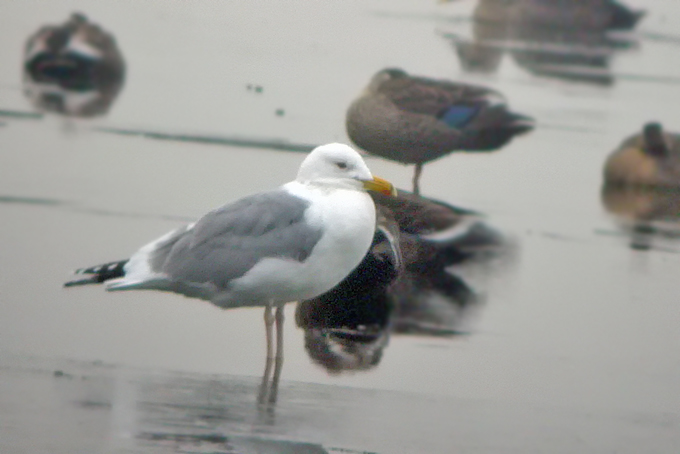
Cheorwon-NE River-Arboretum, January 24
Some excellent birding punctuated by long spells of driving! 40 + Red-crowned and 80+ White-naped Cranes flying out of the DMZ in the early morning at Cheorwon was followed by 10 Scaly-sided Merganser on the NE River (where also 2 Long-billed Plover and several Japanese Wagtail), and great views of a Solitary Snipe at the arboretum.
Song Do and Sorae - Han-Imjin, January 23
An excellent day for gulls, with great views of an adult Relict Gull (with a metal band on its left leg) at Song Do (where also ca 100 Saunders's Gull), 2 "Yellow Sea Gull" at Sorea, and most surprising of all, an adult American Herring Gull seen well (though briefly with no images taken) at flight and on the tidal-flat in the Sorae tidal-creek.
Geum Estuary, Man-gyeong and Gunsan vicinity, January 23

In the estuary about 30 Swan Geese were present. A couple of male Falcated Teal and a female were seen up river. Also there a Japanese Wagtail perched on an electrical wire long enough to be identified. A Water Rail was seen well in a canal near the Geum River. At the Man-gyeong between 5 - 600 Grey Plovers and perhaps 2000 Dunlin were observed from our vantage point at Hwoe-hyun.
Song Do, January 22
Highlights at this highly threatened site included 66 Saunders's and one second winter Relict Gull.
Imjim River, January 22
Cinerous Vultures in groups of up to 50 individuals visible all along the Imjin River from Imjingak. Other sightings included Common Buzzard (3), Northern Sparrowhawk (2), White-tailed Sea Eagle (1 imm) and 250 Ruddy Shelduck.
Joonam Reservoir, January 19
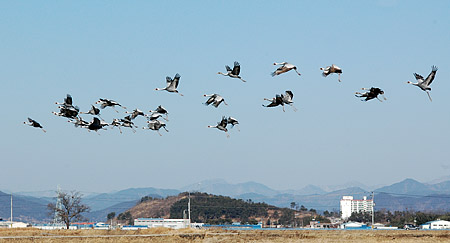
At Joonam today, 35 White-naped Cranes.
Various locations, January 8 - 17
Oriental White Stork (4 at Gocheonam, 12.01.05, 1 at Seosan, 14.01.05)
Swan Goose (ca 30 at Gunsan estuary, 13.01.05)
Red-crested Pochard (1 female at Joonam, 10.01.05)
Steller's Sea Eagle (1 possible at Nakdong estuary, 11.01.05, 1 immature at Hwajinpo, 17.01.05)
Greater Spotted Eagle (1 at Mokpo area: 12.01.05)
Rough-legged Buzzard (1 at Ganghwa, 19.01.05)
Upland Buzzard (2 at Ganghwa, 19.01.05)
Japanese Quail (1 at Ganghwa, hunted by an Upland Buzzard, 19.01.05)
Hooded Crane (at least 40 at Suncheon Bay, 11.01.05)
White-naped Crane (Joonam, 10.01.05, Nakdong River, 11.01.05)
"Eurasian" Oystercatcher (at least 1000 on a sandbank in the Geum River,13.01.05)
Relict Gull (2 at Nakdong River, 10.01.05)
Black Wood Pigeon (1 at Samseonghyeol Shrine on Jeju-Island, 13.01.05)
Short-Eared Owl (1 in the evening at Joonam, 09.01.05)
Red-Flanked Bluetail (1 at Bulguk-sa, 08.01.05, 1 at Samseonghyeol Shrine on Jeju-Island, 14.01.05)
White's Thrush (2 at Samseonghyeol Shrine on Jeju-Island, 13.01.05)
Pale Thrush (1 at Taejongdae, 10.01.05, 10 at Samseonghyeol Shrine on Jeju-Island, 13.01.05)
Chinese Grosbeak (ca 8 near the National History Museum on Jeju-Island, 13.01.05)
Hampyeong, January 16
2 Black Storks
Upo ramsar site, January 16

1700 Taiga Bean Geese, 70 White-fronted Geese, 4 Whooper Swans, 6 White Spoonbills, 1 White-tailed Eagle, 1 Northern Goshawk, 1 Hen Harrier, 1 Long-billed Plover.
Geum River, January 16
On a day that would have been great with a Water Rail, Green Sandpiper, numerous naumanni Dusky Thrush, 200 Coots in the Kunsan Reservoir, 200 Eurasian Curlews on the mud of the estuary, Reed and personata Black-faced Buntings, Olive-backed Pipits and two groups of Azure-winged Magpies, we got more than most birders could ask for...

In the morning we stared at a strange Aythya near the estuary dam for some time, we concluded after after a little discussion and consulting Robson's Guide to the Birds of South East Asia that it had to be a male Ferruginous Duck. We returned to confirm and met Choi Seung-hoon and Kim Tae-hwan who also witnessed and photographed the bird.
[Birds Korea comment: Rare in South Korea, the first documented record was only three years ago on Feb 2nd 2002 at Joonam (go to: New Korean Species: Ferruginous Duck). This adult male (note the white eye of this bird) is the third, following another male at Upo on 22 December 2004.]
Eulsukdo, Busan, January 16
Sunday we had a heavy snowstorm in Busan. Late afternoon we found an Eurasian Eagle Owl at Eulsukdo on the ground in the snow. It was being bothered by many Magpies.
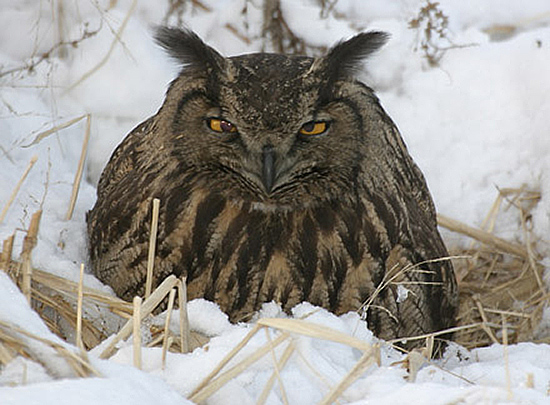
Seosan, Imjim River and Namsan Park, January 15 and 16
Namsan Park 16th January: Japanese Pygmy Woodpecker (4), Grey-headedWoodpecker (2), Greater Spotted Woodpecker (1), Varied Tit (2), Dusky Thrush (all naumanni), (9) and (a first for me in Namsan) a Black -faced Bunting bringing my Namsan Park total to 40 species.

The highlights of a Saturday 15th January morning visit to Seosan produced Oriental White Stork (1), Smew (50), Whooper Swan (9), White-tailed Sea Eagle (1 immature), Steller's Sea Eagle (1 immature), Common Buzzard (3), Upland Buzzard (1).
An afternoon drive along the Han Imjim River to Imjinjak produced another White-tailed Sea Eagle, a Snow Goose and over 300 Cinereous Vultures. The day finished at the Imjin River near to Jeokseong where a second Snow Goose was amongst 3000 mixed Geese together with 4 White-tailed Sea Eagles fighting over a carcass by the side of the River and a further 100 Cinereous Vultures.
Eulsukdo, Busan, January 15
2 Short-eared Owl

Joonam Reservoir, January 13
25 White-naped Cranes

Pohang, January 12
1 Relict Gull.

Geum River and Gunsan vicinity, January 9
At the Geum River Estuary 350+ Saunders' Gulls and 43 Swan Geese were seen - two of which had neck bands. One was blue with white letters which read "R90" parallel to the neck, the other was white with blue lettering and numbers: an "A" written horizontally followed by "32" parallel to the neck.
Also in the vicinity of the estuary 50-60 Northern Lapwings were observed. Further up river another five Swan Geese were seen. A single personata Black-faced Bunting was in an area adjacent to the estuary and in the Okku reservoir a single Red-throated Diver was seen.
Yangyang, January 8
2 White-tailed Eagles and 1 Glaucous Gull.

Ganghwa and ImjingakSokcho-Gangneung, January 7
Only a few hours in the field...at Ganghwa several Naumann's and a single Pale Thrush, along with numerous Varied Tit and Yellow-throated Bunting, but no sign of any Red-crowned Crane. Between Imjingak and Ilsan, at least 450 Cinereous Vulture, 2 or 3 White-tailed Eagle, 4 Swan Goose and 51 White-naped Crane, along with several thousand Greater White-fronted and a few hundred serrirsotris Bean Goose.
Jeju, December 30 - January 7
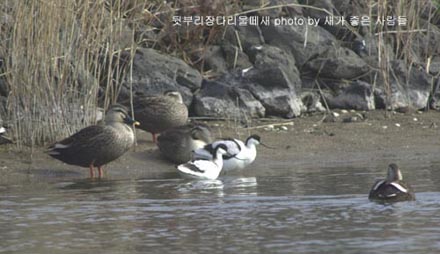
2 Pied Avocets (the species is rare in Korea in winter).
Hampyeong, January 7
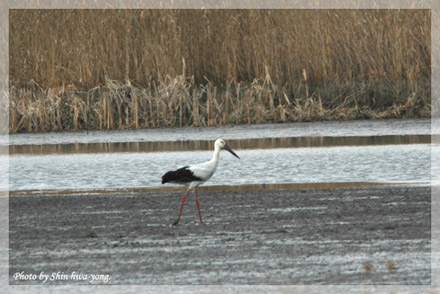
1 Oriental White Stork and 23 Mandarin Duck.
Cheonripo Beach, December 24 - January 5
1 White bellied Green Pigeon.
Rare in South Korea, there have been just the following previous records:
- 1 individual captured Bukjeju Gun, Jeju, 10th April, 1977
- 1 individual captured Hanlim Eup, Jeju, 1989
- 1 individual captured Daejeon, 10th December, 1989
- 1 individual captured Taejongdae, Busan, 1st January, 1992
- 1 individual observed by Jung Ok Sik, Somaemul island, Tongyoung, South Sea, 5th May, 1998
- 4 individuals observed by Kim Su Man, Dok Island, East Sea, October, 1992
(Information from Park Jin Young, 2002. Current status and distribution of birds in Korea. Ph.D. thesis of Kyunghee University.)

Sokcho-Gangneung, January 6
Again, several Russet Sparrow and 2 White-tailed Eagle at Yangyang. At Jumunjin, ca 14 Ancient Murrelet close to shore, along with several Stejneger's White-winged and Black Scoters, with most interesting a very dark-saddled "white-headed" gull, possibly either a barabensis Steppe or perhaps even an eastern cachinnans.
Yangyang north along coast, January 5
With overnight temperatures down to -7C on the coast, most streams now frozen. At Yangyang two White-tailed Eagle, 4 or 5 Russet Sparrow, 5 Siberian Accentor (one finally seen excellently) and 4+ Little in with the more numerous Rustic and Yellow-throated Buntings, with several Meadow and ca 20 Pallas's Reed also present there.
Along the coast, a total of ca 23 Glaucous Gull counted, at least 3 more White-tailed Eagle, 2 or 3 Slavonian, 1 Red-necked and 10+ Black-necked Grebes, ca 75 Black and 10 White-winged Scoters, 15 Harlequin Duck and ca 30 Azure-winged Magpie.
Disappointingly, at Hwajin Po only ca 20 Whooper and no Mute Swan: this site has suffered much recent construction.
Cheorwon and NE River, January 4
At dawn (with a temperature down to a chilly -10 C), very approximately 170 White-naped and 40 Red-crowned Cranes flying out from the DMZ roost, while at the main feeding station (despite increased army restrictions) ca 480 Cinereous Vulture and ca 5 White-tailed Eagle.
In the afternoon, two hours at the stretch of river which held Scaly-sided Merganser in November produced stunning views of at least 9 individuals (two apparent pairs, and several other female-types), along with several Long-billed Plover, Japanese Wagtail and 2 Brown Dipper.
Youngrang lake, East Sea, January 4
6 Mute Swans.
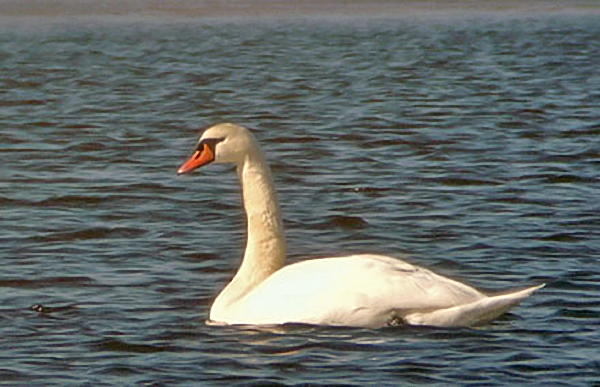
Airport-Gwangneung Arboretum, January 3
Only a couple of hours in the field, in rather overcast conditions. En route, ca 350 Rook and 50 Daurian Jackdaw, 30 Ruddy Shelduck and ca 75 serrirostris Bean Goose in one area of fields, while the arboretum produced two Solitary Snipe, 1 Brown Dipper, 1 rather unseasonal Common Kingfisher, and great views of a couple of White-backed Woodpecker - the latter breaking off several tree branches with their hammering.
Geum River, Okku Reservoir and Gunsan vicinity, January 2
After a good cold wintery week, notable changes were seen in the number of Coots and Red-breasted Mergansers. Today they outnumbered Common Mergansers toward the mouth of the Geum Estuary by several birds to one. A single Green Sandpiper (unusual in winter) was seen as well as a Common. The Baikal Teal are still here in good numbers but they are roosting farther up river - away from the blinds installed for their observation!
We looked today for a bit, but were unable to locate the Red-crested Pochard (a male, present since 19 Dec).





